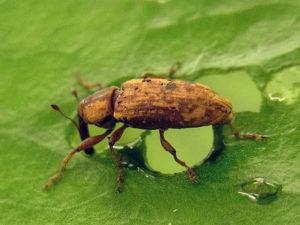Elephant beetle: a dangerous pest with a long nose
A large number of beetles harm agriculture. One of them is a family of beetles weevils, which are also called elephants, for their long proboscis.
Content
What does a weevil beetle look like
Description of the weevil beetle
Name: Weevils or elephants
Latin: CurculionidaeClass: Insects - Insecta
Squad: Coleoptera - Coleoptera
 | Habitats: | everywhere |
 | Dangerous for: | plants, tubers, grains, groceries |
 | Means of destruction: | chemicals, natural enemies |
A characteristic feature is the tube that comes from the front of the head. They, in turn, are divided into two types according to the shape of the organ:
- short-proboscis that develop in the soil;
- long-proboscis, which develop in plant tissues.
The shape and shade of the body depends on which species it belongs to. beetle. They are elongated, spherical, spherical or oblong. The size varies from 30 to 50 mm. Shades can be:
- yellow;
- brown;
- black;
- red-brown;
- copper;
- green.
Sometimes the body can be covered with hairs, scales, bristles, or even a semblance of a crust.
The structure of adults
All representatives of the elephant family have the same structure.
Most often spherical, the rostrum is of different thickness and length. The eyes are small, located on the sides. In some individuals they are reduced. The mouth jaws are simplified.
The scutellum is visible, the shape of the prescutum may vary, be spherical or conical. The abdomen consists of five parts, sternites, the surface of which may differ in structure, be naked or covered with hairs.
The elytra are usually elongated, wide in shape. In some individuals, they can grow together along the seam and metathorax. The presence and type of wings depends directly on the type of beetle itself.
The legs of beetles can be either long or short. Depending on the species, they may be equipped with hairs or extended lower legs, for better swimming or rowing.
Mostly sickle-shaped, white or yellowish in color, covered with pincers or hair. The head is distinctly expressed, round in shape.
Diet preferences
Among weevils there are different representatives. According to the nature of nutrition, they can be:
- monophages;
- oligophages;
- polyphages.
Types of plant pests
Some representatives of weevils can use only one type of plant or representatives of one family, but there are also completely unpretentious polyphages.
How to deal with weevil
The process of fighting the beetle can develop into a full-fledged and protracted war if plant protection procedures are not started in the spring. Each species requires the right approach, but there are general rules for dealing with the flower beetle.
There are several proven ways:
- Mechanical. This is a manual collection, shaking, digging.
- Plant work. This includes cleaning up debris and carrion, removing damaged parts, cleaning the bark, whitewashing trees.
- Passive protection. You can attract birds to the site that will feed on beetles and their caterpillars. Use trapping belts on trees.
- folk methods. These are various infusions and decoctions of plant origin. They have an insecticidal effect.
- Chemicals. This is heavy artillery, which is used in mass infection. Requires precision and caution.
Follow the link for detailed instructions on how to fight. with weevils.
Preventive measures
Of course, prevention will not give a full guarantee that the beetles will not appear on the site. But the number of weevils can be significantly reduced if you follow simple rules.
- observe agricultural technology, rules of care;
- choose the right neighbors;
- carry out pruning and digging, plowing in the fields;
- remove carrion and rubbish;
- timely feed and monitor the health of the plant;
- carry out preventive spring spraying.
Are weevils useful?
Weevil beetles are enemies of agriculture that infect cultivated plants. But among them there are species that feed exclusively on weeds. A dubious option for protecting the garden from pests, but they are an important part of the biocenosis.
Conclusion
Weevil beetles are a large family that are pests of agriculture, fruit bushes, fruit trees and berry crops. They are known for their appetite and can harm different parts of plants.
Previous
